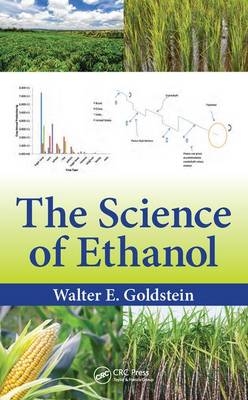
The Science of Ethanol
Crc Press Inc (Verlag)
978-1-4987-2615-3 (ISBN)
Dr. Walter E. Goldstein is President of Goldstein Consulting Company, offering services in chemical engineering and biotechnology (see www.goldconsul.com). He is called upon to improve processes and products in health care, consumer products, food, pharmaceuticals, chemicals, and biofuels. He provides expertise to analyze product and process components, material defects, construction practice defects, and analyses of accidents causing injury. Many of his projects involve biotechnology processes that include mammalian cell, bacterial, and fungal/yeast propagation. He has extensive background in fermentation technology and development of products and processes in this field. He is also President and co-founder of a research and development firm with an active patent. Its objective is to produce universal blood from stem cells in a bioreactor process thereby avoiding use of donor blood for transfusion. He has been involved in bioprocess energy-related projects throughout his career. He was instrumental in leading research and development resulting in a commercial facility to produce ethanol (New Energy of Indiana, $180 million capital investment, 100 million gallons per year facility). His involvement in this book stems from his desire to impact on the alternative energy field in a manner that is synergistic with protecting the environment and helping businesses. Dr. Goldstein was Vice President for Biotechnology Research for Miles, Inc., a former division of Bayer, Inc. from 1982 to 1987. He was also Vice President and Director of Research for ESCA genetics Corporation, a plant sciences biotechnology company from 1988 to 1994. He founded Goldstein Consulting Company in 1994 and has been engaged in several entrepreneurial enterprises since that time. He founded and developed a forensic sciences DNA profiling training laboratory at the University of Nevada Las Vegas from 2003 to 2008. His past publications for Taylor and Francis are Sick Building Syndrome and Related Illness: prevention and remediation of mold contamination in 2011; and Pharmaceutical Accumulation in the Environment: prevention, control, health effects, and economic impact in 2014. He obtained his MBA from Michigan State University in 1968, and is a Registered Professional Engineer. Dr. Goldstein received his Doctorate’s in chemical engineering from the University of Notre Dame in 1973. He is a member of the American Academy of Forensic Sciences, the American Institute of Chemical Engineers, and Sigma Xi. He and his wife, Paula, reside in Las Vegas, Nevada. They have two children and four grandchildren.
Introduction
Yeast Biology and Bulk Manufacture of Ethanol
Processes to prepare ethanol using biotechnology
Yeast biology development
Developing yeast strains to produce ethanol
Nutrients and conditions
Optimization of Ethanol Use as a Fuel
Introduction to the basis of fuel use in the internal combustion engine
Linkage of friction reduction to ethanol fuel use
Thermodynamics of friction dependence on system variables
Coupling of combustion reaction kinetics and thermodynamics
Sample Calculation
Considerations of piston expansion in regard to forces and friction
Computer-based Optimization of the Ethanol Process
Introduction
Specifications for Control of the Ethanol Process
Application of Computer-based Process Control to Ethanol
Optimization Example
Raw Material Resources to produce Ethanol
Plant Raw Material Resources
Biocatalyst Systems for Ethanol Manufacture
Biocatalyst Systems and Processes to isolate and convert Starch and Lignocellulose Components
Biocatalyst Systems for Isolation and Conversion of Starch and Cellulose
Biocatalyst Systems to act on Lignocellulose and its components
Ethanol Process Synthesis for Cost Analysis
Cost Analysis for Optimal Ethanol Manufacture
Cost Analysis objectives to improve ethanol prospects
Cost analysis and Sources of Ethanol
Cost of Ethanol produced using feedstock from corn wet milling facilities
Cost of Ethanol produced using feedstock from corn dry milling facilities
Cost of Ethanol produced using feedstock from lignocellulose sources
Contrast in Costs to produce Ethanol from Feedstocks
Process Optimization and Cost Reduction to reach Commercial Objectives
Considerations for Minimization of Pollution
Introduction to Pollution Considerations
A Sequence of Historical Events that helped to popularize Ethanol
Pollutants in ethanol manufacture and combustion
Impurities in ethanol and gasoline, and in the products of their combustion
Specific Actions on Pollution and Justification
Ethanol Co-Products and Derived Products
Introduction to Co-Products and derived Products
Carbon Dioxide Products and Applications
Ethanol Derived Products and Applications
Petrochemicals as a Source of Ethanol
Conclusions, Recommendations, Research, and Business Directions
| Erscheinungsdatum | 15.03.2017 |
|---|---|
| Zusatzinfo | 8 Tables, black and white; 40 Illustrations, color; 26 Illustrations, black and white |
| Verlagsort | Bosa Roca |
| Sprache | englisch |
| Maße | 156 x 234 mm |
| Gewicht | 680 g |
| Themenwelt | Naturwissenschaften ► Biologie ► Ökologie / Naturschutz |
| Naturwissenschaften ► Physik / Astronomie | |
| Technik ► Elektrotechnik / Energietechnik | |
| Technik ► Umwelttechnik / Biotechnologie | |
| ISBN-10 | 1-4987-2615-1 / 1498726151 |
| ISBN-13 | 978-1-4987-2615-3 / 9781498726153 |
| Zustand | Neuware |
| Haben Sie eine Frage zum Produkt? |
aus dem Bereich


